#48: La Vie En Rose by Grace Jones
City: Ottawa, ON
Radio Station: CFGO
Peak Month: April 1978
Peak Position in Ottawa ~ #5
Peak position in Vancouver ~ did not chart
Peak Position on Billboard Hot 100 ~ #109
Peak Position on Italian Singles chart ~ #3
Peak Position on Dutch Singles chart ~ #4
Peak Position on Belgian Singles chart ~ #13
YouTube: “La Vie En Rose”
Lyrics: “La Vie En Rose”
Grace Jones was born in Spanish Town, St. Catherine, Jamaica, in 1948. Her father was an agricultural worker. When her moved to the United States, her father became a Pentecostal minister. Jones remained with her sisters and brothers in Jamaica and was raised by a grandmother and her second husband. The relationship was physically abusive. Grace Jones moved with her siblings to be with her parents when she was 13 years old. She broke away from her Pentecostal upbringing and became immersed in the Sixties’ counterculture. In her late teens she made a living as a go-go dancer, took LSD and lived in a hippie commune. At the age of 18, she moved to Manhattan and became a Wilhelmina model. She was subsequently hired to walk the runway in modeling shows with Yves St. Laurent, Claude Montana, and Kenzo Takada.
Grace Jones appeared on the covers of Elle, Stern and Vogue.
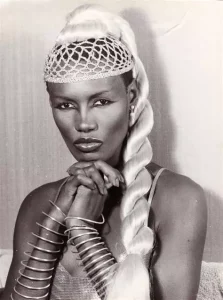
Vogue cover
She was on the cover of the re-issue of Billy Paul’s 1970 album Ebony Woman. That year she appeared in the suspense film Sweet Vengeance. In 1973, she was in the blaxploitation film Gordon’s War. In 1974, she was signed with Island Records. In 1976, Jones appeared as a club singer in the Italian film Quelli della Calibro 38.
The Guardian reflects “In the early 70s, it was the boys (Bowie, Bolan, Iggy) who glamorised androgyny. But by the late 70s Jones was outdoing them. She exuded both grace and menace, femininity and masculinity, and of course sexuality.” In 1976 Jones appeared in the R-rated French film Attention les yeux! The description on Imdb.com states “A bumbling film crew attempts to make a porno movie. Unfortunately, the cast are all egomaniacs or incompetents, and the set manager is too shy to purchase any equipment from the sex shops. Nevertheless, they make do with what they have.”
In 1977, she released her debut album titled Portfolio. It included covers of show tunes “Send In The Clowns” from A Little Night Music, “What I Did For Love” from A Chorus Line, and “Tomorrow” from Annie. She also recorded a cover of Édith Piaf’s signature song “La Vie en rose”.
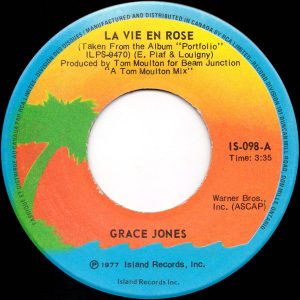
“La Vie en rose” was written by Édith Piaf, with music by Louiguy. The song’s title can be translated as “Life in happy hues”, “Life seen through rose-coloured glasses”, or “Life in rosy hues”; its literal meaning is “Life in Pink.”
Édith Piaf was born in Paris in December 1915. Her birth name was Édith Giovanna Gassion. The name “Édith” was inspired by British nurse Edith Cavil, who was executed 2 months before Édith’s birth for helping French soldiers escape from German captivity during World War I. Twenty years later, Édith’s stage surname Piaf was created by her first promoter, based on a French term for ‘sparrow.’ Her father was an acrobatic street performer, and her mother was a singer and circus performer. Her mother abandoned her at birth, and her father enlisted in WWI in 1916. As a result, Édith was raised by her paternal grandmother in a brothel. During childhood, she lost her sight and regained it in her early teens after a miraculous healing after a pilgrimage to honor St. Thérèse of Lisieux.

Édith Piaf (1946)
She began to accompany her father at the age of 14 and sing, while he did acrobatics. At the age of twenty, she was ‘discovered’ by nightclub owner Louis Leplée. He encouraged her to sing on stage, and as she was 4’8″, he called her ‘The Sparrow Kid.” Her opening performance in Paris included jazz musician Django Reinhardt and French composer Norman Glanzberg. Leplée instructed Piaf to appear in black which became her fashion in almost all of her subsequent live performances. In 1940, she appeared in a play by Jean Cocteau, and performed extensively during WWII in Parisian nightclubs and brothels. She also was taken to Berlin to perform before German high society in the Third Reich. She was later accused of collaborating with the Nazi regime. But witnesses testified that she performed at prisoner-of-war camps in Germany and helped inmates escape. And so she weathered the controversy. In 1944, she performed at the Moulin Rouge cabaret.
Between 1936 and 1959, Piaf appeared in eleven films.
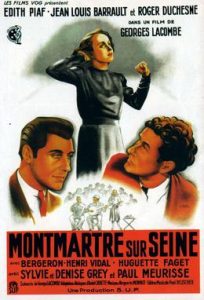
(1941 film starring Édith Piaf)
Her popularity led her to tour across Europe, South America and North America. She appeared on The Ed Sullivan Show on eight occasions. Her most popular songs include “L’Accordéoniste” (1940); “Hymne à l’amour” (1949); “Padam, padam…” (1951); “Non, je ne regrette rien” (1956) which was a number-one hit in Belgium, France and the Netherlands; “La Foule” (1957); and “Milord” (1959-60) which was a number-one hit in France, West Germany and Sweden. Between 1933 and 1963 Piaf wrote and recorded over 300 of her own songs. Her 1946 recording of “Les Trois Cloches” was a huge hit. It was covered in English as “The Three Bells” by The Browns who had a number-one hit with the song in 1959. “Simply A Waltz” is the only song Piaf never sang in French. Piaf performed the song at a dinner for Dwight D Eisenhower in 1952, a few months before he was elected president of the United States. She sang it at the dinner after Eisenhower made the song request. She released a half-French, half-English version of “Autumn Leaves” in 1951.
Piaf was injured in a car accident that occurred in 1951. Both Piaf and singer Charles Aznavour (her then-assistant) were passengers in the vehicle, with Piaf suffering a broken arm and two broken ribs. Her doctor prescribed the drug morphine as a treatment for arthritis, which became a dependency alongside her alcohol problems. Two more near-fatal car crashes exacerbated the situation.
In early 1963, soon after recording “L’Homme de Berlin” with her husband Théo Sarapo, Piaf slipped into a coma due to liver cancer. She was taken to her villa in Plascassier on the French Riviera where she was nursed by Sarapo and her friend Simone Berteaut. Over the next few months she drifted in and out of consciousness, before dying at age 47 on 10 October 1963. Her last words were “Every damn thing you do in this life, you have to pay for.” Shortly after her death, Piaf’s funeral procession drew tens of thousands of mourners onto the streets of Paris, and the ceremony at the cemetery was attended by more than 100,000 fans.
“La Vie en rose” was broadcast live before being recorded. Piaf offered the song to Marianne Michel, who modified the lyrics slightly, changing “les choses” (“things”) for “la vie” (“life”). In 1943, Piaf had performed at a nightclub/bordello called “La Vie en Rose.” Initially, Piaf’s peers and songwriting team did not think the song would be successful, finding it weaker than the rest of her repertoire. Heeding their advice, the singer put the song aside, only to change her mind the next year. It was performed live in concert for the first time in 1946. It became a favorite with audiences. “La Vie en rose” was the song that made Piaf internationally famous, its lyrics expressing the joy of finding true love and appealing to those who had endured the hardships of World War II.
In 1947, Piaf’s recording of the “La Vie en rose” sold a million copies in the United States. It was the best-selling single of 1948 in Italy, and the ninth best-selling single in Brazil in 1949. Piaf performed the song in the 1948 French movie Neuf garçons, un cœur. Her French recording of the song peaked at #23 on the Billboard pop chart in the USA in 1950.
Louis Guglielmi was born in 1916 in Barcelona, Spain. He studied music at the Conservatoire de Paris. He took the pen name Louiguy. In addition to writing the melody for “La Vie en rose”, in 1950 he wrote the Latin jazz composition “Cerisier rose et pommier blanc”. It was made famous in English as “Cherry Pink (and Apple Blossom White)”, which was recast as a resounding mambo international number-one hit in 1955 for Pérez Prado. He created almost three dozen film scores, beginning in 1946 with La Rose de la mer and including Mourir d’aimer (1970; in English To Die of Love). Among the last was the score for Jean Gabin’s final gangster flick, Verdict (1974). He died in 1991, in the medieval walled town of Vence, France, one day after his 75th birthday.
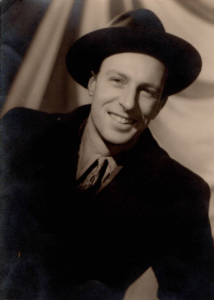
Louiguy
“La Vie en rose” is a song about a romance and the “the magic spell…cast” by one’s beloved. They list aspects of their romantic relationship:
a) When you kiss me, heaven sighs
b) When you press me to your heart, I’m in a world apart, a world where roses bloom
c) When you speak angels sing from above
d) Every day words seem to turn into love songs
In 1950, Tony Martin had a #9 hit in the USA with “La Vie en rose”. That year Bing Crosby took the song to #13. While Louis Armstrong’s version reached #28. The song has been covered by Gracie Fields, Dean Martin, Swedish pop singer Gustaf Torrestad, Swiss performer Lothar Löffler, Italian singers Natalino Otto, Carlo Buti, and Nilla Pizi, Harry James and His Orchestra, Victor Young, Owen Bradley, Austrian bandleader Horst Winter, Cuban singer Roberto Pereda, Jo Stafford, Ella Fitzgerald, Marlene Dietrich, Danish performer Svend Saaby, Frank Chacksfield, Mantovani, Lionel Hampton, Roger Williams, Erroll Garner, Sam Butera and the Witnesses, Percy Faith, Bert Kaempfert, Mr. Acker Bilk, Jane Morgan, and many others.
In Grace Jones version she adds a bossa nova beat to the song. In addition, she sings a new verse in English near the end of “La Vie en rose”:
When he takes me in his arms
And whispers love to me
Everything’s lovely
It’s him for me and me for him
All our lives
And it’s so real what I feel
This is why.
Grace Jones 1977 recording of “La Vie en rose” peaked at #5 in Ottawa, #16 in Montreal, and the Top 40 in Detroit. Internationally, the song climbed to #3 in Italy, #4 in the Netherlands, #12 in the UK, #13 in Belgium, and #20 in Spain. It stalled at #109 just below the Billboard Hot 100. However, on the Billboard Dance Club chart it reached #10.
Later in 1977, Grace Jones original 1975 single release, “I Need A Man”, topped the Dance Club chart in the USA, and #19 on the Belgian pop chart. That year, another track from Portfolio, titled “Sorry”, reached #7 on the Billboard Dance Club chart. While Portfolio reached #8 on the Dutch album chart, and #9 in Italy. In 1978, “Do Or Die” reached #3 on the Dance Club chart in the USA, and #13 on the pop chart in Spain.
In 1978, Grace Jones was a regular on the Italian TV series Stryx. That year her second studio album, Fame, reached #15 in Italy and #22 on the Swedish pop album chart. The title track, “Fame”, climbed to #3 on the Billboard Dance Club chart. However, her third studio album, Muse, released in 1979 was less commercially successful. As was her fourth studio album Warm Leatherette. But in 1981, her single “I’ve Seen That Face Before (Libertango)” topped the pop charts in Belgium, #2 in the Netherlands, #9 in Switzerland, #14 in Spain and #16 in West Germany. Later that year “Pull Up to the Bumper” soared to #2 on the Billboard Hot Dance Club Play chart, and #5 on the Hot Soul Singles chart. The song reached #10 in Ireland, #12 in the UK, #13 in Finland and New Zealand, #14 in Belgium, and #16 in the Netherlands. The accompanying album, Nightclubbing, peaked at #2 in the Netherlands, #3 in New Zealand, #4 in Sweden, and #8 in West Germany. It also reached the Top 20 on album charts in Australia, Norway and Spain.
In 1982, Grace Jones released Living My Life. The debut single, “Nipple To the Bottle”, peaked at #3 in New Zealand, and at #7 in Belgium and the Netherlands. It also reached #2 on the Billboard Dance Club chart. In 1983, Grace Jones received a Billboard Music Award nomination for Top Disco Artist – Female.
In 1984, Grace Jones appeared alongside Arnold Schwarzenegger in Conan the Destroyer. That year she received a Grammy Award nomination for A One Man Show in the Best Video Album category. In 1985, Grace Jones appeared in a lead role of May Day in the James Bond film A View to A Kill. That year Jones was the recipient in West Germany of Bravo Magazine’s Bravo Award for Best Female Actress.
In 1985, Jones released her seventh studio album titled Slave to the Rhythm. The album reached #7 in Austria, #8 in the Netherlands, #9 in Switzerland, #10 in West Germany, #11 in New Zealand, #12 in the UK, #13 in Norway and #15 in Italy. The title track reached number-one on the Billboard Dance Club Songs chart, #3 in the Netherlands, #4 in Belgium and West Germany, #5 in New Zealand and Switzerland, #6 in Italy, and #7 in Austria. “Slave to the Rhythm” also reached the Top 20 on the pop charts in Australia, Finland, Spain and the UK. In 1986, Jones was nominated in the Best Female Video category for “Slave to the Rhythm”. In 1986, she appeared as a stripper and vampire in the comedy horror movie Vamp. In 1986, Grace Jones’ cover of the Roxy Music tune “Love is the Drug” reached #18 in Ireland. Her 1986 album, Island Life, topped the pop album chart in New Zealand, climbed to #4 in the UK, #9 in Australia, #10 in Austria, #14 in the Netherlands, and #15 in Italy.
In 1986, Jones released her eighth studio album titled Inside Story. Her single “I’m Not Perfect (But I’m Perfect For You)” climbed to #4 on the Billboard Dance Club/Play chart, #9 on the pop chart in New Zealand, #11 in Finland, #15 in Italy, #16 in Spain, and #18 in Belgium. The following year she played a sorceress in the movie Siesta.
In 1989, “Love On Top of Love” topped the Billboard Dance Club chart, and was a modest hit in the Netherlands and Spain. The album, Bulletproof Heart, was also released that year.
In 1992, Jones played opposite Eddie Murphy in the romantic comedy Boomerang. The following year she appeared in the sci-fi movie Cyber Bandits. As well in 1997, Jones was with a touring stage company performing in The Wiz: The Super Soul Musical “Wonderful Wizard of Oz”. In 1998, Jones was featured in a Behind the Music episode about the Manhattan dance club Studio 54. That year she sang the theme song “Storm” for the movie The Avengers. In 1999, Jones appeared as a warrior in an episode of the TV show Beastmaster. In 2001 Jones was cast as a queen in the TV movie Shaka Zulu: The Citadel.
In 2008, Q Magazine chose Grace Jones for recipient of its Icon Award. That year she released her tenth studio album titled Hurricane. It cracked the Top 30 on the pop album charts in Austria, Belgium (#14), Greece, Switzerland and West Germany. On June 4, 2012, Jones performed “Slave to the Rhythm” at the Diamond Jubilee Concert in celebration of Queen Elizabeth II’s 60th anniversary as British monarch. In 2015, she published her memoir titled I’ll Never Write My Memoirs.

Kirkus Reviews wrote “”[Grace] Jones reflects on a high flying life of celebrity exuberance…In her candid reflections, Jones writes about her lovers…her constant quest for new experiences and willingness to try new things, and the free-flowing social circles of fashionistas, artists, and musicians… [Her] recollections are a passionate reminder of the fabulous, decadent, and manic coupling of life and art.”
In 2016, she starred in her 19th film Gutterdämmerung, about rock n’ roll music, but set in the 1920s. Jones has received The Voice of a Woman award in 2017. That year she received the Career Achievement Award at the Bahamas International Film Festival. As well, a documentary was released in the UK titled Grace Jones: Bloodlight and Bami. In 2023, Grace Jones received a Grammy Award nomination in the Album of the Year category for her vocal contributions to Beyoncé’s 7th studio album titled Renaissance. She has also appeared on albums with other recording artists including Lil Kim, the Thompson Twins, Arcadia, Brigitte Fontaine, and Janelle Monáe. As of this writing, Grace Jones is 77 years old and has performed in concert this year in Norway, Switzerland and the USA.
October 17, 2025
Ray McGinnis
References:
Shilpa Ganatra, “Grace Jones: Carry Yourself with Class,” Irish Times, October 28, 2016.
Simon Hattenstone, “Grace Jones: ‘God I’m scary, I’m scaring myself,” Guardian, April 17, 2010.
Édith Piaf, “La Vie en rose“, Columbia Records, 1946.
Bing Crosby, “La Vie en rose“, Decca Records, 1950.
Tony Martin, “La Vie en rose“, RCA Victor Records, 1950.
Louis Armstrong, “La Vie en rose“, Decca Records, 1950.
Trailer, Conan the Destroyer, Universal Pictures, 1984.
Trailer, A View to A Kill, MGM/UA, 1985.
Trailer, Cyber Bandits, Columbia/TriStar Pictures, 1993.
Excerpt, “The Umpatra“, Beastmaster, CTV, 1999.
Grace Jones, “I Need A Man“, Island Records, 1977.
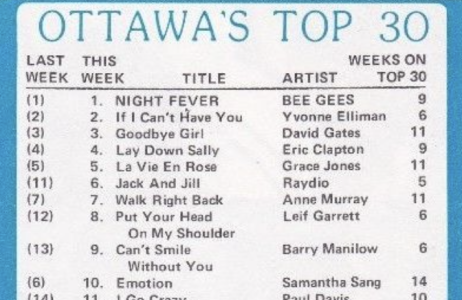
CFGO 1440-AM Ottawa Top Ten | April 17, 1978

Grace Jones cover of La Vie En Rose is my 2nd favorite cover of this song. Edith Piaf’s being my first of course. I’ve been a big fan of Mrs. Jones since the late 70s. After decades she still an amazing entertainer. Thank you for this fabulous review.